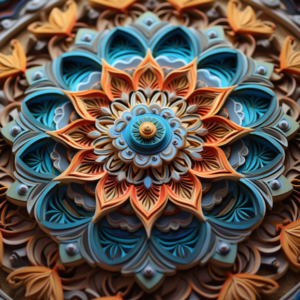Mandalas are not only a universal symbol of unity and harmony but also a cross-cultural phenomenon, deeply ingrained in the spiritual and artistic traditions of diverse civilizations. These mesmerizing circular patterns can be found in various cultures, each infusing mandalas with unique meanings and symbolism. In this article, we will embark on a captivating journey to explore the fascinating use of mandalas in different cultures around the world.
1. Hinduism and Buddhism:
In Hindu and Buddhist traditions, mandalas hold profound spiritual significance. Mandalas are used in various rituals and meditation practices to represent the universe’s structure and the journey towards enlightenment. Mandalas feature prominently in the design of sacred temples, meditation spaces, and religious art, symbolizing the unity of all life and the pursuit of inner peace.
2. Native American Cultures:
Native American cultures incorporate mandala-like patterns in their artwork and spiritual practices. These geometric motifs, often known as medicine wheels, reflect the interconnectedness of all living beings and the cycles of life. Medicine wheels are used in ceremonies, healing rituals, and as a means to connect with nature and the spirits of the land.
3. Tibetan Buddhism:
Tibetan Buddhism is renowned for its intricate and vibrant mandalas, known as “sand mandalas.” Skilled monks create these ephemeral masterpieces using colored sand, meticulously pouring the sand into elaborate patterns that symbolize the impermanence of life. Once completed, the sand mandalas are ritually dismantled, signifying the transient nature of existence.
4. Celtic Tradition:
In Celtic cultures, mandala-like designs, such as the Celtic knot, are prevalent in ancient artwork, jewelry, and illuminated manuscripts. These intricate patterns symbolize the interconnectedness of all things and the eternal cycles of life, death, and rebirth. Celtic mandalas evoke a sense of mystery and spiritual depth in their beautifully intertwined motifs.
5. Islamic Art:
Islamic art is renowned for its mesmerizing geometric patterns, often featuring mandala-like elements. These intricate designs, known as Arabesque, reflect the Islamic belief in the divine order of the universe. Islamic mandalas grace mosques, architecture, and decorative arts, serving as a visual expression of devotion and harmony.
6. Native Australian Aboriginal Art:
In Aboriginal art, circular designs similar to mandalas are used to convey spiritual stories and connect with the Dreamtime, the realm of creation and ancestral spirits. These sacred symbols, known as “songlines,” depict the interconnectedness of the land, animals, and people and serve as a means of passing down cultural knowledge and wisdom.
7. Aztec and Mayan Civilization:
The Aztec and Mayan civilizations of ancient Mesoamerica incorporated mandala-like designs into their architecture, pottery, and religious art. These circular patterns symbolized cosmic order and the cyclical nature of life, linking humanity with celestial forces and the divine.
Conclusion: The Universal Language of Mandalas
As we journey through the diverse cultures and artistic traditions, we witness the universal language of mandalas, transcending geographical boundaries and time. Whether in Hinduism, Buddhism, Native American cultures, Tibetan Buddhism, Celtic traditions, Islamic art, Native Australian Aboriginal art, or ancient Aztec and Mayan civilizations, mandalas resound with a powerful message of interconnectedness, spirituality, and harmony. Across the world, mandalas continue to captivate and inspire, beckoning us to recognize the unity that binds all cultures and the beauty of our shared human experience.
Celebrate Unity in Diversity – Embrace the Global Mandalas!
Celebrate the rich tapestry of cultures and their unique expressions of mandalas as you delve into the world of diverse symbolism and spiritual significance. Embrace the global mandalas that speak the universal language of interconnectedness and unity, bridging the gap between different cultures and touching the depths of the human soul. Revel in the beauty of cultural diversity as you explore the mesmerizing artistry of mandalas from various corners of the world.



